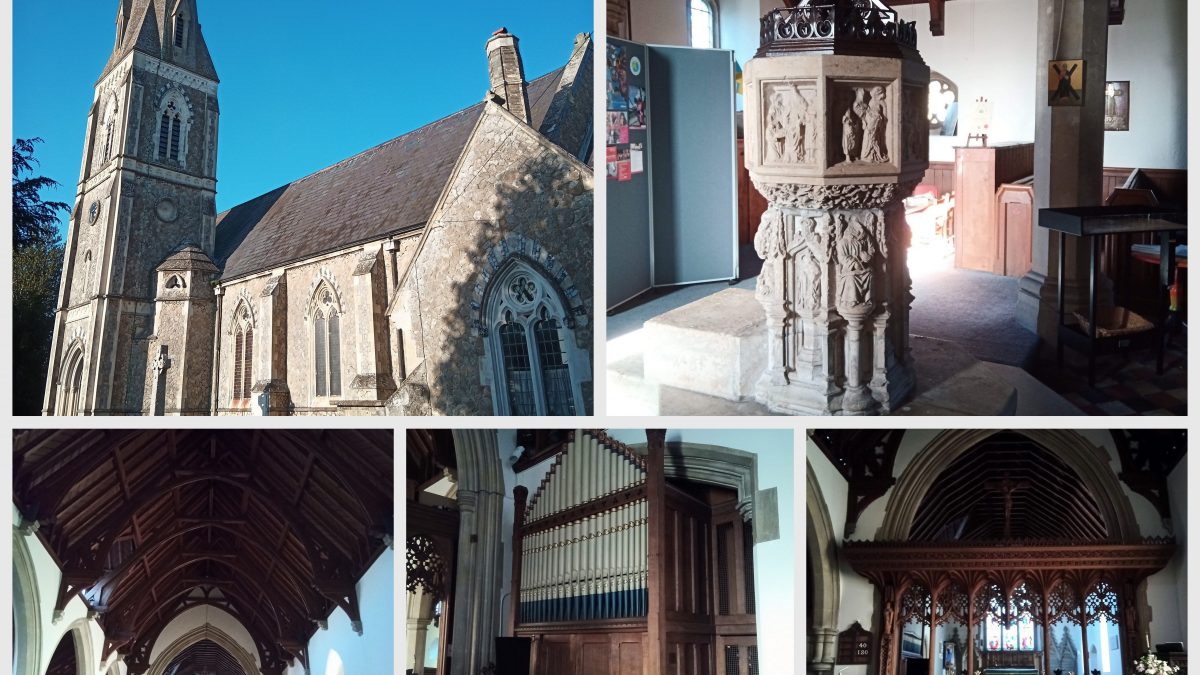Recently, it has occurred to me that this blog goes relatively long periods without entries of any significance or, worse still, no activity at all. Well, knock me over with a feather duster and call me Beryl! This of course does not mean that I am lying prostrate on my chaise longue surrounded by cherubs feeding me grapes and generally attending to my every whim (apparently).
So treat this entry as an illustration of the sort of everyday business that we don’t normally feel is significant enough to be worthy of recording. By way of an exemplar if you will. Our first foray was to Framlingham in search of a church interior, the exterior of which we have circled on many an occasion. The Church of St.Michael. It has been built, rebuilt and added to down the ages. A surviving feature, the capitals of the Chancel arch, date from the twelfth century but the majority of the church was built in the perpendicular style between 1350 and 1555. The roof is especially glorious with intricate fan tracery which conceal hammer beams. The roof itself dates from about 1521. The font is earlier, dating from the fifteenth century and is an excellent example of a typical East Anglian font of that period.
It is most known for being the host of the Norfolk Tombs – the first (going clockwise) being the coloured alabaster tomb against the north wall of the chancel. This commemorates Henry Earl of Surrey and his wife Frances de Vere, daughter of the l5th Earl of Oxford. Surrey was born in 1517 at the house of his father, the 3rd Duke of Norfolk, at Kenninghall. His classical education at the hands of scholars and his study of Virgil later gave him a poetical talent two hundred years ahead of his time. He is to this day referred to as `The Poet Earl’. In his youth he found favour with King Henry VIII and formed a deep friendship with the Duke of Richmond. In later years Surrey inherited his father’s military genius in a tactical sense and distinguished himself at Boulogne and Landrecy. His pride of ancestry and his foolhardiness in the dangerous days at the close of Henry VIII’s reign left him open to the intrigues of those who plotted for the court supremacy which would come after the King’s death. Surrey was tried for treason on fabricated charges at Guildhall on l3th January 1547 and executed on the 2lst. Look up the rest for yourself :-).
Undoubtedly though, one of the most noted features of the church is the world famous 17th Century Thamar organ. Only eight large-scale organs in total survived the English Civil War as Oliver Cromwell apparently had a dislike of their ornate style and ordered them to be destroyed. Of these, there are just three remaining Thamars. The other examples being in Gloucester Cathedral and St Nicholas’s church in the hamlet of Stanford upon Avon, Northamptonshire. That’s definitely worth knowing, so here it is – documented!
The second foray was to another church (of St. Andrew) in Melton. Tucked off the main thoroughfare. A Grade II listed building, the great feature of the interior is the late medieval font which was brought here from the old church (which this one replaced). It is one of Suffolk’s 13 seven sacrament fonts, one of only ten that have surviving imagery. It is slightly more battered than many of its companions, but it is particularly interesting for its unique 8th panel, which shows the martyrdom of St Andrew. It also has a characterful ‘last rites’ panel, with a chamber pot and a pair of slippers under the dying man’s bed, as at Badingham. This font must have been one of the last of the series; the vine work under the bowl is reminiscent of that on the font at Walsoken in Norfolk, one of the very last fonts to be made in England before the Reformation intervened. Built of Kentish Ragstone (the architect used it despite it being wholly wholly inappropriate for a Suffolk village. Be that as it may, the new St Andrew is a well-used, well-loved church, and there is much evidence of this inside its rather dimly-lit interior.
So, there you have it. Self evidently proving that not everything gets recorded in the blog; whilst also simultaneously engendering enormous outpourings of relief for those who have mistakenly ventured here in some incalculable and half hearted belief that some apocryphal tale about three toed sloths and the desolate nature of the Suffolk wilderness has some basis in truth.


